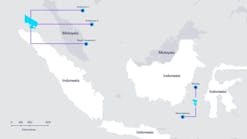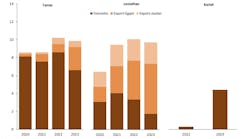Offshore staff
HOUSTON -- Total is protecting the subsea christmas trees on the Dalia field offshore Angola with gel to prevent hydrates forming during production shutdowns. The company outlined the background to this development in a paper delivered today at DOT.
Subsea trees are the first component of the production system which comes into contact with the exiting well stream. In normal conditions, the effluent emerges hot and under pressure, but if cooled (i.e. through contact with a cold christmas tree), it can transform into gas hydrates which can block the flowline system.
Total first observed the rapid cooling rates of the Dalia trees during a shutdown in December 2006. One critical cold spot identified on the trees was defective sealing of the cavity housing the connector of the choke module. It appeared that the convection phenomenon induced by continuous circulation of cold sea water was preventing the sea water within the cavity from warming. This led to thermal inertia in that section of the tree.
During Dalia project development, specifications for the trees required at least eight hours for the effluent to cool from 45º C to 20º C (113-68º F). But during further shutdowns in 2007, effluent temperature from other wells downstream of the choke achieved this drop in less than 1 ¼ hours. Gel injection was selected as the most efficient way to block the convective exchanges in the trees’ choke modules. An initial procedure was applied in December 2007 on two pilot wells, using a specially developed, ROV-operated skid.
Dalia’s subsea system in general operates in a temperature of around 4º C (39º F), and must be insulated to ensure a minimum temperature of the wellstream both on its way to the field’s FPSO (30-35º C, or 86-95º F, at the riser head), and during shutdowns. The insulation must allow the operator sufficient time to preserve the subsea network before hydrate formation.
The subsea production contractor, Aker Solutions, commissioned CRP to design and apply onto the metal body of each tree a thermal insulation resin layer comprising a polyurethane resin matrix with glass microspheres. As the connector on the choke module was not easy to insulate (due to difficulties with ROV handling), a sealed cavity was designed around the connector to render the entire assembly thermally inert.
The first christmas tree in the program underwent a cooling test to validate the design. This involved running hot water in a loop at a temperature similar to that of the effluent (around 50º C, or 122º F), with the tree immersed in water a temperature of 8º C (46º F). Temperature variations were recorded at points around the tree, within the fluid system, and on the structure. Results were used to refine the design and to predict the behavior of the trees under static and transient conditions.
However, problems installing the protective cap on some trees resulted over time in shrinking of the insulating material, even deformation, raising concerns over the material’s resistance to stress. The cause proved to be inclusions of air in the material, which led to changes when subjected to hydrostatic pressures.
Total commissioned French research institute Ifremer to conduct aging tests in hyperbaric chambers on alternative gels. The only one to pass all the tests was Mergel, supplied by Norwegian company Amek, which had a density slightly higher than that of seawater, meaning it would stagnate at the bottom of the choke cavity, where the connector is located. Total developed an ROV-operable skid to inject this gel, involving syringes activated by hydrostatic pressure supplied by the ROV’s high-pressure pump.
Results in two pilot wells showed that despite cooling, the two christmas trees remained above 20º C for longer than eight hours. All Dalia’s trees now are pre-filled systematically with gel prior to deployment, and Total may extend the concept to the projects. The aim is to design an insulation that would no longer be molded, but composed of cavities around the christmas tree, simplifying maintenance of the equipment.
02/02/2010




